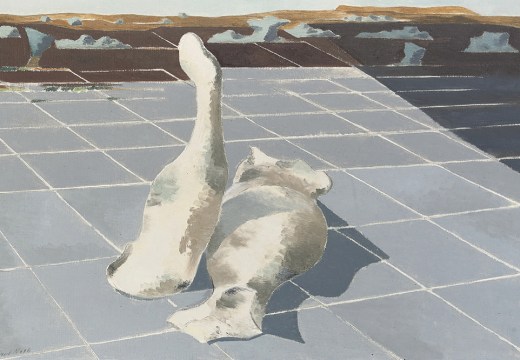The Canadian artist Raine Storey composes humorous and intriguing visual stories that reimagine everyday scenarios and personal memories through fragmented, hyperreal imagery, bright, gestural brushstrokes and large areas of white space. Her work is currently on display as part of the group show ‘Behind the Canvas’ at The ARX gallery until 28 June; she is also the gallery’s artist-in-residence.
How much do you plan your compositions?
I tend to have an overall concept, or theme in mind. So, for instance, with the painting Airport and Security (2022), I wanted to play with some of the quirky and creative elements of going through the security, and how chaotic that experience can be. I like to work with visual double entendres, to essentially make light of different subject-matter. In that piece I mentioned, there’s a chicken with a cat’s head, which came about very spontaneously while I was painting. So, while I might have certain images, or fragments of a particular scene in my mind perhaps from some preliminarily visual research, the outcome is often completely different.
Your works typically encompass intense areas of mark-making alongside large areas of negative space. How do you think that contrast impacts the image as a whole?
Those areas of negative space are really important to me as it allows parts of the story to be hidden, and it creates a sense of mystery for the viewer. I used to work very realistically and I got to a point where I felt very comfortable with that style of representation and I wanted to challenge myself. Abstraction is always something that’s terrified me. There’s much more choice in a way: I get to pick the entire composition, the movement, the colour palette. Worst of all, I have to decide when to stop and put the brushes down.

Airport and Security (2022), Raine Storey. Courtesy The ARX gallery Photo: James Mason Photography. Courtesy The ARX gallery
How do you decide when a painting is finished?
That’s a tough question. I think it’s when I feel like I’ve achieved what I’m trying to portray: when the idea or theme is visible but the work still looks abstract when you’re standing at a distance from the canvas. I like that the story might not immediately reveal itself and it’s only when you spend longer looking at the piece that you start to piece together the different images and themes.
That said, I’m always wanting to do more, to attack it a little bit further. When I get to a point of not knowing whether to add something new or leave it as it is, I will step away from the work for a while. It can be really useful to return with a fresh, slightly distanced perspective so that I can judge whether something is actually working and whether the eye moves through the piece in the way that I want it to.

Storey at work in her temporary studio at The ARX gallery. Photo: James Mason Photography. Courtesy The ARX gallery
Do you find the more realistic elements still come more easily to you?
Yes, for sure. Realism is my comfort zone: I see something and I reproduce it with my paint brush, while playing around with a few elements here and there. However, I do also like feeling slightly uncomfortable while I’m working as I think that different emotions feed into the piece and ultimately, make it more compelling.
Are there any movements or artists that you’re particularly inspired by?
My papa, the artist Derek Woodhead, who I just lost, was my mentor and critic. He had such an amazing eye and we were constantly talking about art and going to galleries together. I spent a lot of time with him as a kid: he taught me how to paint. Naturally, I took a lot of inspiration from being in his studio surrounded by his pieces, which are very Surrealist, dreamlike and romantic. This was before I even knew what Surrealism was, but it definitely gave me an interesting perspective of the world and art.
‘Behind the Canvas’ is at The ARX gallery, Knightsbridge, London until 28 June 2022.
Unlimited access from just $16 every 3 months
Subscribe to get unlimited and exclusive access to the top art stories, interviews and exhibition reviews.














![Masterpiece [Re]discovery 2022. Photo: Ben Fisher Photography, courtesy of Masterpiece London](http://www.apollo-magazine.com/wp-content/uploads/2022/07/MPL2022_4263.jpg)
Has the Fitzwilliam lost the hang of things?